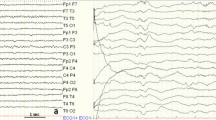We present a historical review of the concepts of Russian researchers regarding the mechanisms and functional roles of sleep – I. P. Pavlov and his predecessors (I. R. Tarkhanov and M. M. Manaseina) and students (N. A. Rozhanskii and K. M. Bykov). This analysis leads to the conclusion that sleep is linked with the realization of functional operations not previously associated with sleep and not addressed by current neuroscience. Thus, a real understanding of sleep functions can be expected to come only with a new neurophysiological paradigm.
Similar content being viewed by others
References
I. R. Tarkhanov, “Experiments on natural sleep in animals,” Zdorov’e, 121, 371–372 (1879).
M. Shoifet, 100 Great Doctors, www.masiki.net/books/Mikhail-SHoyfet_100-velikikh-vrachey/79].
I. R. Tarkhanov, Psychomotor Center and their Development in Humans, Panteleev Press, St. Petersburg (1979).
I. P. Pavlov, Selected Works, Kh. S. Khoshtoyants (ed.), State Political Literature Press, Moscow, Leningrad (1949).
I. R. Tarkhanov, “Observations and experiments on the light-emitting apparatus of Italian fireflies,” in: Studies of the Russian Society of Doctors, St. Petersburg (1894–1895), pp. 104–112.
V. M. Kovalzon, “Maria Manasseina – a forgotten founder of sleep science,” J. Sleep Res., 3, No. 2, 128–134 (1994), https://doi.org/10. 1111/j.1365-2869.1994.tb00117.x.
V. M. Koval’zon, “A forgotten founder of biochemistry and somnology,” Priroda, 5, 85–89 (2012).
M. M. Manaseina, Sleep as a Third of the Life of Humans, or the Physiology, Pathology, Hygiene, and Psychology of Sleep, Russkaya Tipo-Litografiya, Moscow (1892).
M. de Manaseïne, “Quelques observations experimentales sur l’influence de l’insomnie absolue,” Arch. Ital. Biol., 21, 322–325 (1894).
L. Daddi, “Sulle alterazioni degli elementi del sistema nervoso centrale nell’insomnia sperimenmtale,” Riv. Patol. Nerv. Ment., 3, 1–12 (1898).
G. Tarozzi, “Sull’influenza del’insomnio sperimentale sulricambio materiale,” Riv. Patol. Nerv. Ment., 4, 1–23 (1899).
C. Cirelli, P. J. Shaw, A. Rechtschaffen, and G. Tononi, “No evidence of brain cell degeneration after long-term sleep deprivation in rats,” Brain Res., 4, 184–193 (1999), https://doi.org/10.1016/S0006-8993 (99)01768-0.
I. P. Pavlov and L. N. Voznesenskii, “Sleep physiology,” in: Twenty Years of Objective Investigation of Higher Nervous Activity (behavior) in Animals, Nauka, Moscow (1973).
N. A. Rozhanskii, Sleep Physiology, State Medical Literature Press, Moscow (1954).
R. A. Lemkul’, “Comparison of the shift between sleep and waking in normal and decerebrate pigeons,” Fiziol. Zh. SSSR im. Sechenova, 19, No. 3, 622–631 (1935).
V. M. Koval’zon, “The role of the orexinergic system of the brain in regulating waking and sleep,” Effekt. Farmakoter. Nevrol. Psikhiatr., Spec. Iss., Sleep and Its Disorders, 19, 6–16 (1916).
V. M. Koval’zon, Basic Somnology. Physiology and Neurochemistry of the Sleep–Waking Cycle, Binom. Lab. Znanii, Moscow (2011).
Pavlov’s Clinical Wednesdays 1931–1933, USSR Academy of Sciences Press (1954), Vol. 1., pp. 104–105, 164–165, 209–212,
I. N. Pigarev and M. L. Pigareva, “Asynchronous development of sleep as the likely cause of decreased cognitive functions and the occurrence of a number of pathological states associated with the ‘sleep–waking’ cycle,” Effekt. Farmakoter. Nevrol. Psikhiatr., Spec. Iss., Sleep and Its Disorders, 22, 6–14 (2014).
I. N. Pigarev and M. L. Pigareva, “Partial sleep in the context of augmentation of brain function,” Front. Syst. Neurosci., 8, 75–87 (2014), https://doi.org/10.3389/fnsys.2014.00075.
I. S. Aleksandrov, K. M. Bykov, G. E. Vladimirov, G. A. Dmitriev, N. G. Malitskaya, M. Ya. Mikhel’son, A. M. Nikitina, G. N. Pribytkova, A. V. Rikkl’, and A. A. Rogov, “Changes in animals’ bodies in prolonged sleep deprivation,” in: K. M. Bykov, Selected Works, Yu. M. Protusevich (ed.), Medgiz, Moscow (1958).
I. N. Pigarev and M. L. Pigareva, “The state of sleep and the current brain paradigm,” Front. Syst. Neurosci., 9, 139–143 (2015), https:// doi.org/10.3389/fnsys.2015.00139.
Author information
Authors and Affiliations
Corresponding author
Additional information
Translated from Zhurnal Nevrologii i Psikhiatrii imeni S. S. Korsakova, Vol. 117, No. 4, Iss. II, Sleep Disorder, pp. 91–97, April, 2017.
Rights and permissions
About this article
Cite this article
Pigarev, I.N., Pigareva, M.L. A Long and Difficult Path towards Understanding the Purpose of Sleep. The Period before Electrophysiology. Neurosci Behav Physi 49, 75–80 (2019). https://doi.org/10.1007/s11055-018-0695-0
Published:
Issue Date:
DOI: https://doi.org/10.1007/s11055-018-0695-0




